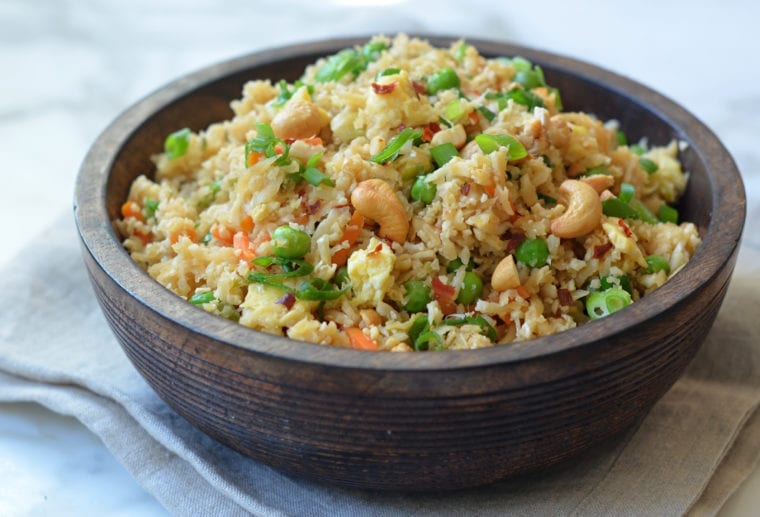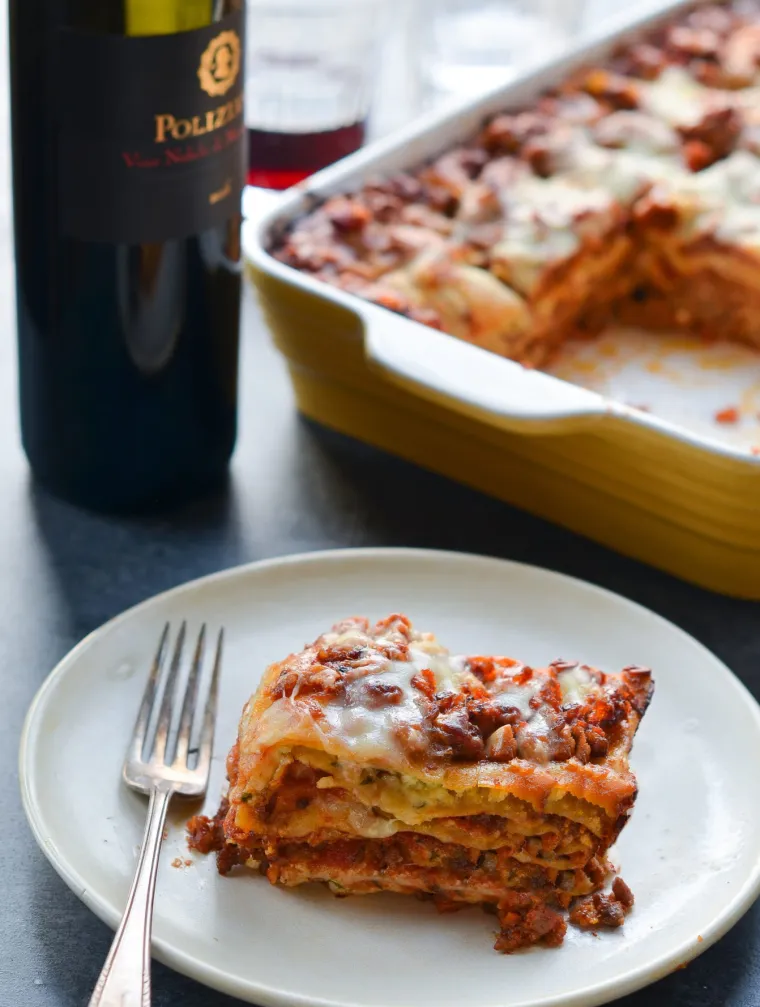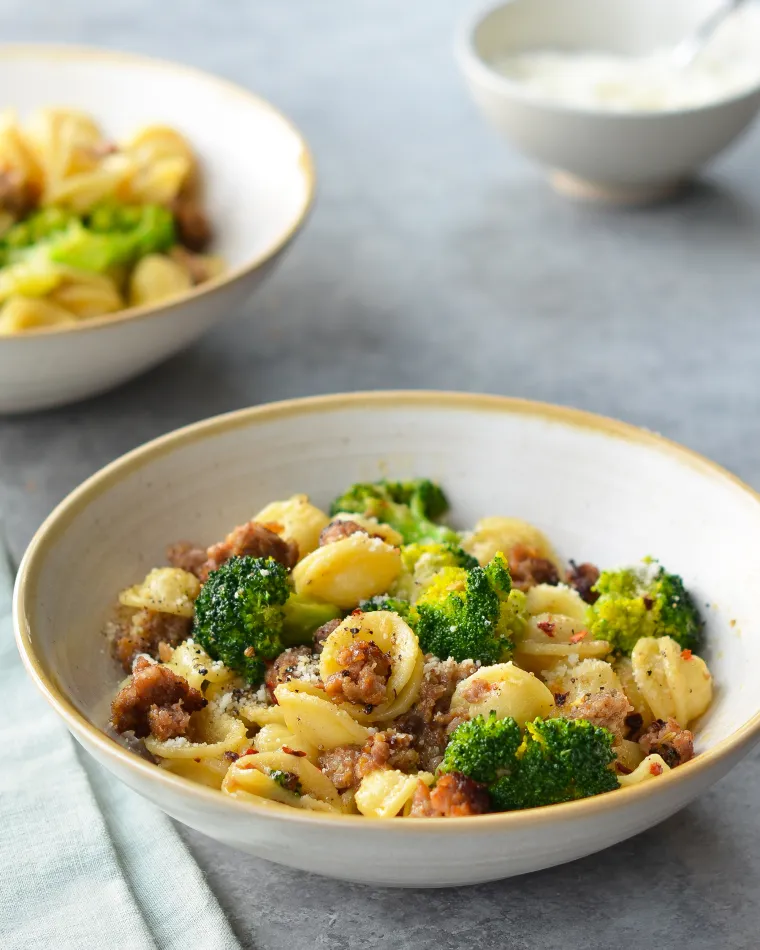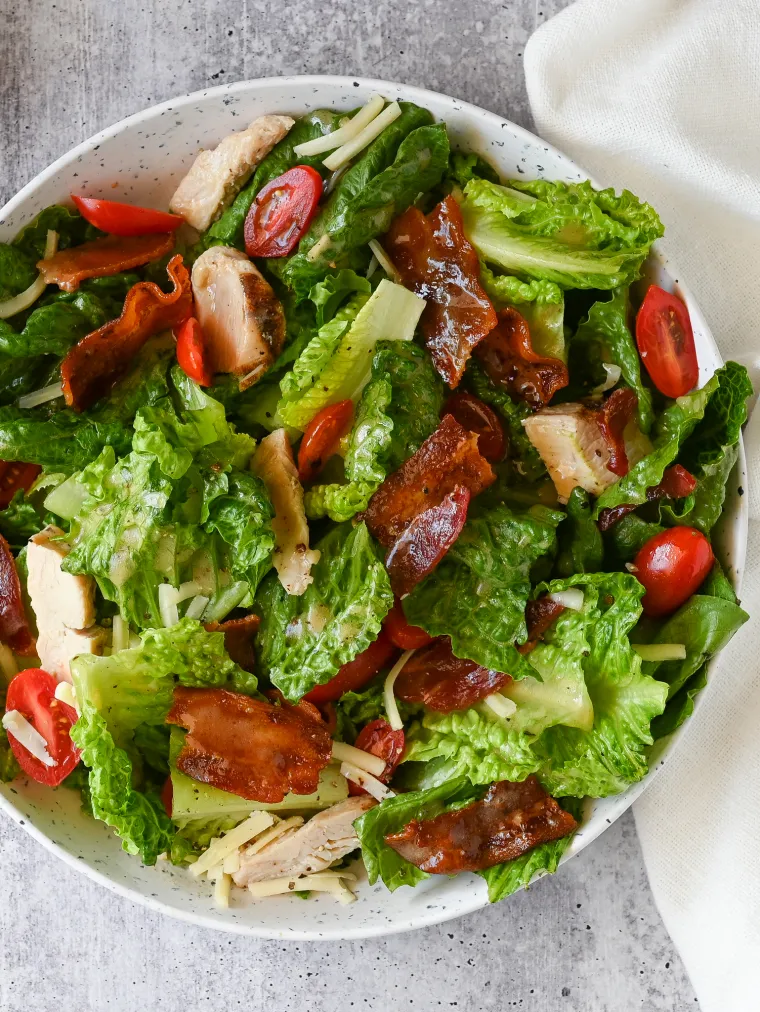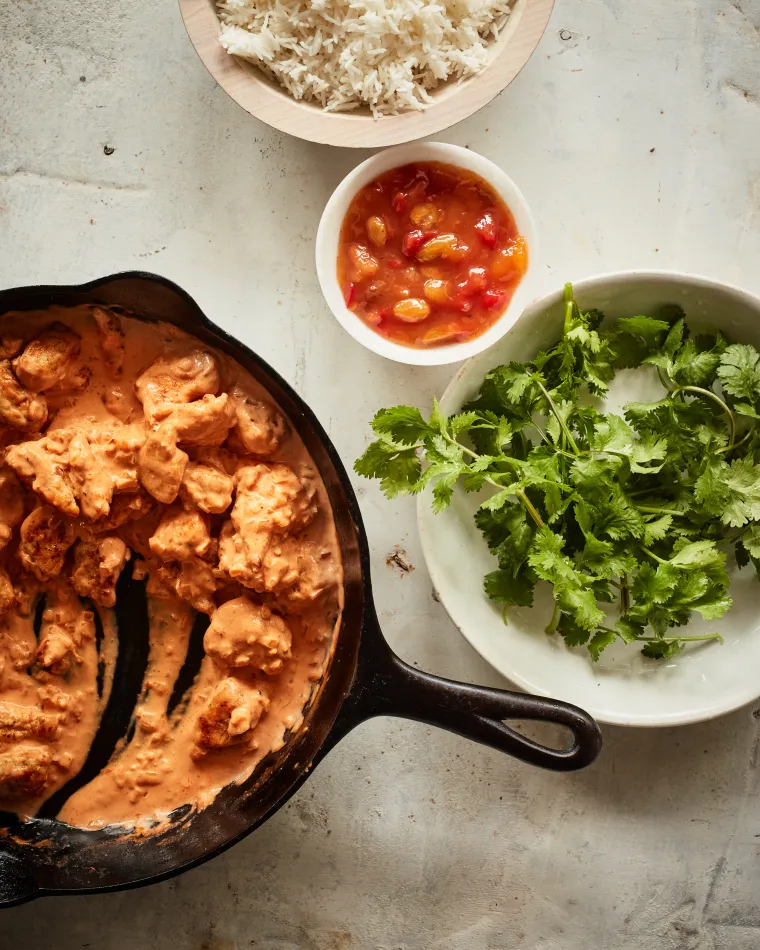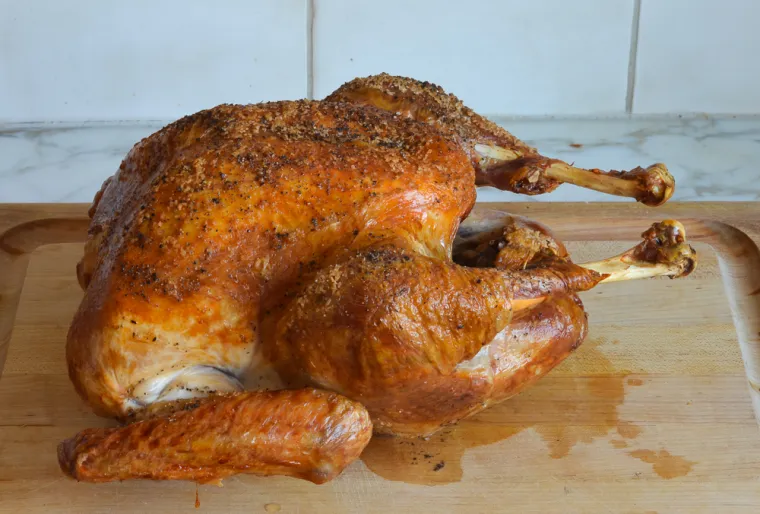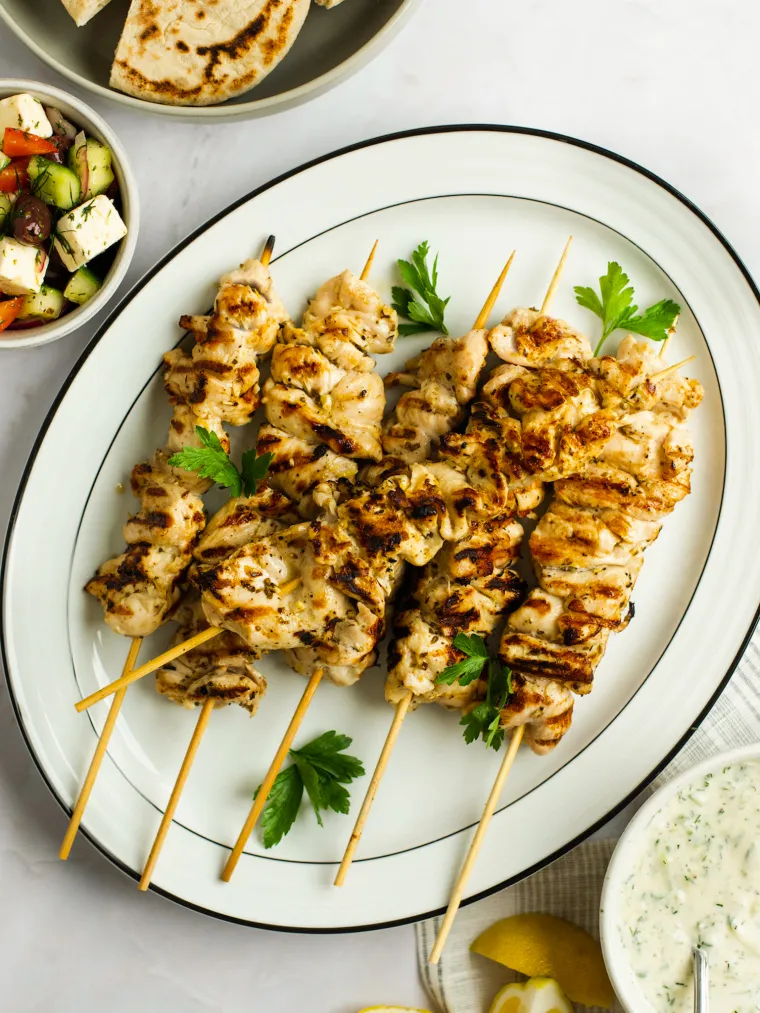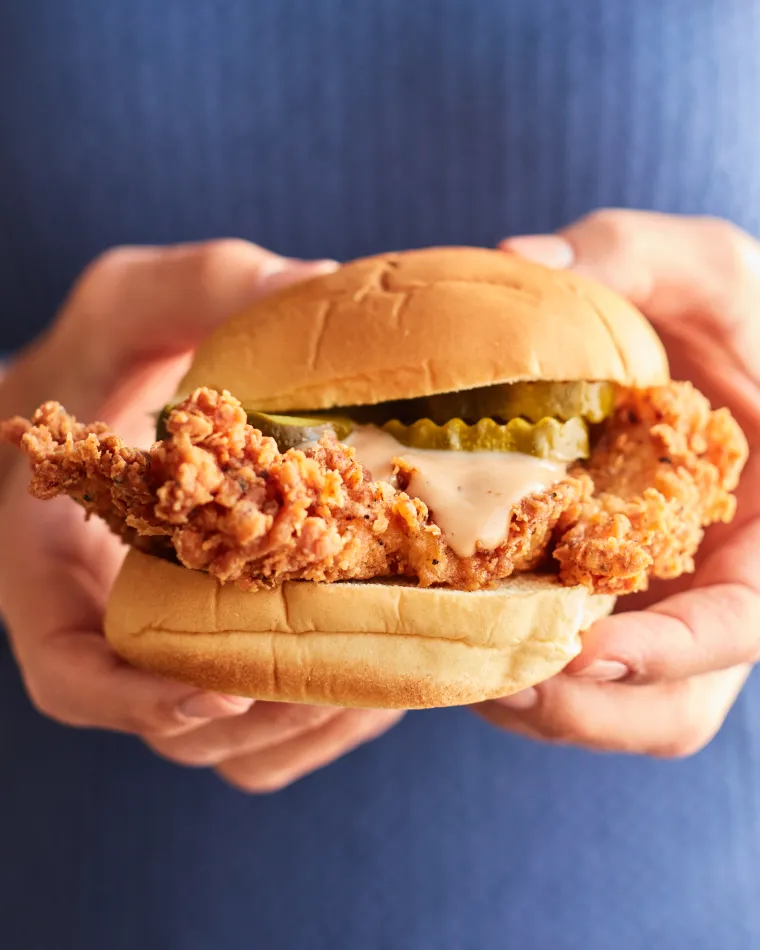Articles contributed by the community, curated for your enjoyment and reading.
Filters
Reset
This Chinese-style cauliflower fried rice is a healthy, low-carb dish that’s hearty enough to serve as a main course.
Cauliflower rice — which is just cauliflower grated into rice-like bits — really does taste similar to rice, or at least it behaves similarly by soaking up all the flavor of its seasonings. In this quick and easy cauliflower fried rice recipe, I sauté grated cauliflower with aromatics, vegetables, soy sauce, and eggs, much like Chinese fried rice. It’s a healthy, low-carb dish that’s hearty enough to serve as a main course.
Cauliflower has a mild flavor that makes it an excellent blank canvas for other flavors. In addition to rice, it makes a great substitute for mashed potatoes in my cauliflower purée with thyme recipe. It’s also excellent roasted in my roasted cauliflower recipe.
What You’ll Need To Make Cauliflower Fried Rice
You’ll likely be able to find grated cauliflower in the produce or frozen vegetable section of your supermarket. But if not, it’s simple to make using a food processor (use the grating disc) or hand grater.
How To Make Cauliflower Fried Rice
As with any quick stir-fry, it’s important to have all of your ingredients prepped before you start cooking.
Begin by heating a few teaspoons of oil in a large nonstick skillet over medium heat. Add the eggs and a pinch of salt and cook over medium heat until scrambled.
Set the eggs aside, then sauté the scallions, ginger, and garlic in oil until softened.
Add the grated cauliflower, soy sauce, red pepper flakes, sugar, and salt. Cook, stirring often, for about 3 minutes.
Add the peas and carrots and continue cooking until the cauliflower “rice” is tender-crisp and the vegetables are warmed through, a few minutes.
Stir in the rice vinegar, sesame oil, dark green scallions, nuts (if using), and scrambled eggs.
Taste and adjust seasoning if necessary. Serve hot and enjoy!
Note: This recipe has been written by Jenn Segal and republished on MudMatter with Author’s Permission. Please find the original link here – Cauliflower Fried Rice.
The recipe by Jenn Segal
I love this lasagna recipe because it combines the comforting flavors I grew up with and the elegance of a restaurant-style dish. It's easy to make thanks to oven-ready (no-boil) noodles, which save time and taste almost like fresh pasta. The layers feature a rich meat sauce with Italian sausage, vegetables, crushed tomatoes, and cream, along with creamy ricotta, gooey mozzarella, and Parmesan cheese. Baked until golden and bubbly, it’s the perfect dish for a crowd and holds up well when reheated or frozen. This is my go-to lasagna recipe!
What you’ll need to make lasagna
No-boil lasagna noodles are a convenient option found in the pasta section of most grocery stores. I personally recommend the Barilla brand. These noodles don't require boiling, making them easier to use without the hassle of sticking together, which is common with traditional lasagna noodles.
Step-by-Step Instructions
1. Make the Sauce
Begin by placing the onions, garlic, carrots, and celery in a food processor. You need to give them a rough chop first, otherwise, they won’t chop evenly.
Pulse until minced but not puréed, so that they melt into the sauce.
Heat 2 tablespoons of the olive oil in a large pot over medium-high heat, and add the sausage.
Cook, stirring occasionally and breaking the sausage into small pieces, until slightly browned but not cooked all the way through, about 5 minutes. Using a slotted spoon, transfer the partially cooked sausage to a plate. Set aside.
Add the remaining tablespoon of olive oil to the pan, reduce the heat to medium, and add the minced vegetables.
Cook, stirring frequently, until the vegetables are very soft, 6 to 8 minutes. Do not brown; reduce the heat if necessary.
Add the wine and continue cooking, stirring to scrape any brown bits from the bottom of the pan, until the wine is mostly absorbed by the vegetables, a few minutes.
Add the tomatoes, cream, salt, pepper, sugar, thyme and bay leaves.
Stir and bring to a boil.
Reduce the heat and simmer until the sauce is thickened, about 20 minutes.
Add the sausage back to the pot.
Continue simmering until the sausage is fully cooked and the flavors all meld together, about 10 minutes. Taste and adjust seasoning if necessary. Fish out the bay leaves and discard.
2. Make the Ricotta Filling
Combine the ricotta, cream cheese, egg, garlic, Parmigiano-Reggiano, salt and pepper in the bowl of a food processor fitted with a metal blade.
Process until evenly combined, then add the basil.
Pulse until the basil is finely chopped.
3. Assemble the Lasagna
Spread about 1-1/2 cups of sauce in the bottom of the baking dish.
Arrange 3 noodles over the sauce, and dollop a third of the ricotta filling over the noodles.
Spread the ricotta mixture evenly over the noodles.
Sprinkle with 3/4 cup mozzarella cheese.
Repeat layering of sauce, noodles, ricotta filling and mozzarella 2 more times. Top with the remaining 3 noodles. Spoon the remaining sauce over the noodles, then sprinkle with the remaining mozzarella and 1/4 cup Parmigiano-Regg
Spray a large piece of foil with nonstick cooking spray. Cover the lasagna tightly with the foil, sprayed side down. Bake for 40 minutes in a 375°F oven. Carefully uncover and increase the oven temperature to 400°F. Bake, uncovered, until the noodles are tender, the sauce is bubbling, and the edges are golden and puffed, about 20 minutes.
Remove from the oven and let stand for 15 to 20 minutes before serving.
Note: This recipe has been written by Jenn Segal and republished on MudMatter with Author’s Permission. Please find the original link here – Classic Lasagna.
This orecchiette pasta dish is packed with flavor and quick to make — and the whole family gobbles it up, broccoli and all.
Sometimes it seems impossible to make a meal that pleases the whole family. What one child happily eats, the other one is “not in the mood for.” But every once in a while, I come upon a recipe that everyone lvoes, like this orecchiette pasta dish adapted from Lidia’s Italian Table by Lidia Bastianich. Not only is it quick and easy to make — 25 minutes tops — but the whole family devours it, broccoli and all.
What you’ll need to make orecchiette with Sausage & Broccoli
Orecchiette is named for its shape, which resembles a small ear (the Italian word orecchiette means small ear). If you can’t find it, it’s fine to substitute another pasta, like farfalle or fusilli.
talian sausage is a great ingredient to have on hand for weeknight dinners. Not only is it quick and easy to cook, but it’s also flavored with a variety of aromatics, herbs and spices, such as garlic and fennel, which add depth and complexity to pasta dishes without the need for a lot of additional seasoning. This makes it an easy and convenient way to add flavor to pasta dishes, such as baked ziti and lasagna. Buy bulk sausage, or sausage meat without the casing, if possible (it’s often easy to find around holiday season as it’s used in stuffing recipes). Otherwise, just squeeze the sausage meat out of the casing.
Pecorino Romano is a hard, salty, and pungent Italian cheese made from sheep’s milk. It’s readily available in grated form in the cheese section of most large supermarkets but if you can’t find it, it’s fine to substitute Parmigiano Reggiano.
How to make orecchiette with Sausage & Broccoli
Begin by cooking the pasta.
Meanwhile, heat 1 tablespoon of the olive oil in a large skillet and add the sausage.
Cook, breaking the meat up with a spoon, until the sausage starts to brown, 5 to 6 minutes.
Add the garlic and cook a minute more.
Add the remaining 4 tablespoons of olive oil, broccoli, chicken broth, salt and red pepper flakes. Cook, stirring frequently, until the broccoli is tender-crisp, 3 to 4 minutes.
Stir in the butter until melted and simmer for a few minutes to reduce and concentrate the sauce.
Add the sausage and broccoli mixture to the drained pasta and toss well, along with half of the grated cheese.
Transfer the pasta to a serving bowl or individual bowls and top with the remaining grated cheese.
Note: This recipe has been written by Jenn Segal and republished on MudMatter with Author’s Permission. Please find the original link here – Orecchiette with Sausage and Broccoli.
If you love BLTs but crave something lighter without sacrificing flavor, this BLT salad with grilled chicken hits the spot. It’s all the goodness of your favorite sandwich in a satisfying salad.
If you like BLTs, then this flavor-packed BLT salad is for you. Along with the B, the L, and the T, there’s grilled chicken and shredded Cheddar cheese thrown in for good measure, making the salad substantial enough to serve as a main course. If you’d like to make all the components from scratch, I recommend this easy hands-off method for cooking the bacon and leftovers of this grilled chicken recipe. That said, I often use store-bought shortcuts for this salad, like pre-washed romaine hearts, fully-cooked bacon that just needs to be zapped in the microwave, and the grilled chicken slices sold in the refrigerated section at the grocery store (rotisserie chicken works great, too).
The only thing I insist on making from scratch is the vinaigrette, and that only takes a few minutes. Keep in mind that the recipe makes two generous main course salads, so if you’re serving more people, adjust accordingly. The vinaigrette keeps nicely for several days and can be made ahead of time.
What you’ll need to make blt salad with chicken
Step-by-Step Instructions
Put the lettuce in a large bowl, pour about 1/2 cup of the vinaigrette onto the lettuce, and toss well. Taste and add a few more tablespoons of vinaigrette, if desired.
Add the bacon, chicken, tomatoes, and cheese.
Toss gently to combine. Serve the salad with the remaining dressing on the side.
Note: This recipe has been written by Jenn Segal and republished on MudMatter with Author’s Permission. Please find the original link here – BLT Salad with Chicken.
This easy butter chicken recipe features ultra-tender chicken simmered in a rich, creamy, spice-infused tomato sauce.
A staple menu item in many Indian restaurants in the U.S., butter chicken was supposedly created when a restaurateur in India combined leftover chicken with a tomato sauce enriched with butter and cream. Traditionally, the chicken for this dish is marinated in yogurt, lemon, and spices and then cooked in a clay oven called a tandoor. To save time and make the dish home cook-friendly, I sauté unmarinated, seasoned chicken in a skillet and then briefly simmer it in a creamy, spice-infused tomato sauce. This results in ultra-tender chicken. In fact, one reader remarked that this must be called “butter chicken” because the chicken is so tender, it’s like “buttah!” Along with basmati rice or naan, I love a little mango chutney on the side; it adds a delicious gingery sweetness that complements the chicken.
What You’ll Need To Make Butter Chicken with Mango Chutney
Step-by-Step Instructions
In a medium bowl, sprinkle the chicken pieces evenly with 3/4 teaspoon of the salt and 1 teaspoon of the garam masala; toss to coat evenly.
Add the flour.
Toss again, making sure the chicken is well coated.
In a large nonstick skillet, heat 1 tablespoon of the butter and the oil over medium-high heat. When the fat is hot and shimmering, add the chicken in a single layer and cook, without stirring, until the chicken is lightly golden on the underside, about 3 minutes.
Using tongs, turn the chicken pieces over and cook until just cooked through, 2 to 3 minutes more. Using the tongs, transfer the chicken to a plate and set aside while you make the sauce (you’ll use the skillet in the next step—there’s no need to wash it).
Melt the remaining tablespoon butter in the same skillet over medium heat. Add the onion and ginger and cook, stirring frequently, until softened, 3 to 4 minutes.
Add the coriander, cumin, cayenne (if using), and remaining teaspoon of garam masala; stir and cook 1 minute more.
Add the tomato sauce, cream, sugar, pepper, water, and the remaining 1/2 teaspoon salt. Bring to a gentle boil, then reduce the heat and simmer, uncovered, until slightly thickened, about 3 minutes.
Add the chicken along with any accumulated juices, to the sauce.
Simmer a few minutes, until the chicken is warmed through.
Taste the sauce and adjust the seasoning if necessary. Sprinkle with the cilantro, if using.
Serve with basmati rice and mango chutney.
Note: This recipe has been written by Jenn Segal and republished on MudMatter with Author’s Permission. Please find the original link here – Butter Chicken.
This template is for a clean structured ASP.NET Core API project, following the RESTful principles, Clean Architecture principles, SOLID design principles, implementing the Dependency Injection, Repository, and Unit of Work design pattern, and utilizing Entity Framework Core for data access. It provides a standardized structure and organization for building robust and maintainable ASP.NET Core API applications with complete CRUD (Create, Read, Update, Delete) operations.
Project Structure
The project structure is designed to promote separation of concerns and modularity, making it easier to understand, test, and maintain the application.
├── src
│ ├── Core # Contains the core business logic, domain models, view models, etc.
│ ├── Infrastructure # Contains infrastructure concerns such as data access, external services, etc.
│ └── API # Contains the API layer, including controllers, extensions, etc.
├── tests
│ ├── Core.Tests # Contains unit tests for the core layer
│ ├── Infrastructure.Tests # Contains unit tests for the infrastructure layer
│ └── API.Tests # Contains unit tests for the API layer
└── README.md # Project documentation (you are here!)
REST API
The API project contains the controllers responsible for handling HTTP requests and responses, adhering to RESTful principles. Here’s an overview of the key components involved in building RESTful APIs using ASP.NET Core:
Controllers: The API project contains controllers that handle HTTP requests and responses. Each controller is responsible for a specific resource or entity. Controllers define HTTP methods (GET, POST, PUT, DELETE) that map to specific actions for CRUD operations on entities.
Models/DTOs: The Core project may contain Data Transfer Objects (DTOs) that represent the data to be sent over the API. DTOs help in decoupling the client’s data format from the server’s data format.
Routing: The routing mechanism in ASP.NET Core maps incoming HTTP requests to the appropriate controller and action method based on the URL. RESTful APIs typically use a resource-based URL pattern.
HTTP Methods: RESTful APIs use standard HTTP methods (GET, POST, PUT, DELETE) to perform CRUD operations on resources. Each HTTP method corresponds to a specific action on the API.
Status Codes: RESTful APIs use standard HTTP status codes to indicate the success or failure of an API request. For example, 200 (OK) for successful GET requests, 201 (Created) for successful POST requests, 204 (No Content) for successful DELETE requests, etc.
Validation: RESTful APIs should include proper validation logic to ensure that incoming data is valid and adheres to the expected format.
Getting Started
To use this project template, follow the steps below:
Ensure the .NET 7 SDK is installed on your machine.
Clone or download this repository to your local machine.
Open the solution in your preferred IDE (e.g., Visual Studio, Visual Studio Code).
Build the solution to restore NuGet packages and compile the code.
Configure the necessary database connection settings in the appsettings.json file of the Infrastructure project.
Open the Package Manager Console, select Project.Infrastructure project, and run the Update-Database command to create the database.
Run the application by starting the Project.API project.
Project Features
This project template includes the following features:
Clean Architecture: The project is structured according to the principles of Clean Architecture, which promotes the separation of concerns and a clear division of responsibilities.
SOLID Design Principles: The code adheres to SOLID principles (Single Responsibility, Open-Closed, Liskov Substitution, Interface Segregation, and Dependency Inversion), making it easier to maintain and extend.
Repository Pattern: The repository pattern abstracts the data access layer and provides a consistent interface for working with data.
Unit of Work Pattern: The unit of work pattern helps manage transactions and ensures consistency when working with multiple repositories.
Entity Framework Core: The project utilizes Entity Framework Core as the ORM (Object-Relational Mapping) tool for data access.
ASP.NET Core API: The project includes an ASP.NET Core API project that serves as the API layer, handling HTTP requests and responses.
CRUD Operations: The project template provides a foundation for implementing complete CRUD (Create, Read, Update, Delete) operations on entities using Entity Framework Core.
Dependency Injection: The project utilizes the built-in dependency injection container in ASP.NET Core, making it easy to manage and inject dependencies throughout the application.
Unit Testing: The solution includes separate test projects for unit testing the core, infrastructure, and API layers.
Usage
The project template provides a starting point for building RESTful APIs using ASP.NET Core. You can modify and extend the existing code to suit your specific application requirements. Here’s an overview of the key components involved in building RESTful APIs:
Models: The Core project contains the domain models representing the entities you want to perform CRUD operations on. Update the models or add new ones according to your domain.
Repositories: The Infrastructure project contains repository implementations that handle data access operations using Entity Framework Core. Modify the repositories or create new ones to match your entity models and database structure.
Services: The Core project contains services that encapsulate the business logic and orchestrate the operations on repositories. Update or create new services to handle CRUD operations on your entities.
Controllers: The API project contains controllers that handle HTTP requests and responses. Update or create new controllers to expose the CRUD endpoints for your entities. Implement the appropriate HTTP methods (GET, POST, PUT, DELETE) and perform actions on the core services accordingly.
Make sure to update the routes, validation, and error-handling logic to align with your application requirements and best practices.
Note: This article has been written by Kawser Hamid and republished on MudMatter with Author’s Permission. Please find the original link here – Clean Structured API Project – ASP.NET Core.
Ideal for turkeys under 14 pounds, the high-heat method guarantees a juicy and crisp-skinned turkey.
The high-heat roasting method is one of my favorite ways to cook a turkey. The prep time is minimal, the cooking time is short, and the turkey emerges from the oven juicy and crisp-skinned. The only drawback is that the high heat can cause a little smoke in the kitchen, so be sure your oven is spotless prior to cooking — and while the bird roasts, turn on your exhaust fan and crack a window. This cooking method only works for turkeys under 14 pounds. For larger birds, I recommend this dry-brined turkey recipe.
For Thanksgiving, I typically make one roast turkey along with a rolled stuffed turkey breast (a make-ahead family favorite) so we have variety and plenty of leftovers. Finally, if you’re a turkey novice or cooking a turkey feels intimidating, check out my best turkey advice; it will make you feel better!
What you’ll need to make roast turkey with Gravy
How to make roast turkey with Gravy
To begin, remove and discard truss that holds turkey legs together. Trim off and discard any excess fat in the neck or body cavity. Remove giblets and neck; discard or save for stock.
Rinse turkey inside and out with warm water. Pat dry with paper towels. Place a V-shaped rack in a 13 x 16 x 3-inch heavy stainless-steel roasting pan. (Do not use a dark roasting pan or a disposable aluminum pan.)
Rub the turkey skin all over with the olive oil and sprinkle with the salt and pepper. Set the bird breast-side-up on the rack. Pull the wings away from the body, then firmly twist them to push the wing tips under the bird.
Using aluminum foil, form caps over the tips of the end of each drumstick. (Do not tie the legs together, add stuffing, or close the body cavity.) Insert a digital leave-in meat thermometer near the center of the breast through thickest part until the tip touches the bone. Turn on your exhaust fan and crack a kitchen window.
Place the turkey in the oven and roast, without basting, until the thermometer reaches 160°F, 1 to 1-1/2 hours. Halfway through roasting time, rotate the pan in the oven to assure even cooking and browning. (If at any point your kitchen gets unbearably smoky or the fat is spitting, pour a cup of tepid water in the roasting pan. Just keep in mind that liquid will create steam, which prevents the skin from getting as crispy.) Remove the pan from the oven.
Using oven mitts that you don’t mind getting dirty, carefully tilt the turkey so that the juices from the cavity run into the roasting pan. Transfer the turkey to a platter or cutting board (do not clean the roasting pan), tent the turkey with foil, and let it rest for 20 to 30 minutes. This will allow the internal temperature to reach at least 165°F (the USDA safe-cooking temperature for turkey) and the juices to settle.
How To Make Gravy
While the turkey rests, make the gravy: Place the roasting pan over a burner on your stove. (Be careful handling the pan, as the handles will be hot.) Skim away any excess fat or solids that have accumulated in the pan.
In a medium saucepan, melt the butter over medium-low heat.
Add the onions.
Cook until very soft and translucent, about 15 minutes. Do not brown.
Add the flour.
Whisk and cook for 2 to 3 minutes, stirring occasionally.
Whisk in the turkey dripping-chicken broth mixture and Cognac and cook, uncovered, stirring occasionally, for about 5 minutes until thickened.
Stir in the cream (if using) and chopped herbs. Taste and adjust seasoning with salt and pepper, if necessary.
Transfer to a gravy bowl. Carve the turkey and serve with the gravy on the side.
Note: This recipe has been written by Jenn Segal and republished on MudMatter with Author’s Permission. Please find the original link here – Easy High-Heat Roast Turkey with Gravy.
This cashew chicken with tender stir-fried chicken and roasted cashews in garlic sauce tastes just like take-out.
This cashew chicken, or stir-fried chicken with roasted cashews in garlic sauce, tastes just like take-out from your favorite Chinese restaurant. It’s easy to make at home. You don’t need a wok — just a large nonstick skillet — and, aside from the chicken, the only chopping involves garlic and scallions. The rest of the ingredients come out of bottles and jars. As with all stir-fries, the dish cooks quickly, so be sure to have all your ingredients prepped before you start cooking. Also, be sure not to cut the chicken pieces too small, or they will cook too quickly and overcook.
What You’ll Need To Make Cashew Chicken
Be sure to use a high-quality hoisin sauce like Kikkoman or Lee Kum Kee; it makes a big difference.
How To Make Cashew Chicken
To begin, place the cashews on a baking sheet in a single layer.
Toast in the oven until fragrant, about 5 minutes. (They will crisp up as they cool.) Meanwhile, prepare the sauce: in a small bowl, whisk together the water, cornstarch, hoisin sauce and soy sauce. Set aside.
Next, season the chicken with salt and pepper. In a large nonstick skillet, heat 1 tablespoon of the vegetable oil over high heat until very hot. Add half of the chicken to the skillet
Stir-fry until lightly browned but not cooked through, about 3 minutes. Transfer to a plate.
Add the remaining tablespoon vegetable oil to the skillet; then add remaining chicken, garlic and white parts of the scallions. Stir-fry until the chicken is lightly browned but not cooked through, about 3 minutes. Return the first batch of chicken to the pan. Turn the heat down to medium and add the rice vinegar; cook until evaporated, about 30 seconds.
Add the sauce mixture and cook, stirring frequently, until the chicken is cooked through, about 1 minute.
Remove from the heat. Stir in the scallion greens, cashews and sesame oil.
Serve with rice.
Note: This recipe has been written by Jenn Segal and republished on MudMatter with Author’s Permission. Please find the original link here – Cashew Chicken.
Bring a taste of Greece to your own backyard with souvlaki: succulent skewers of lemony chicken, grilled to perfection.
“Chicken again?” That’s the familiar chorus in our home every time I mention it’s chicken for dinner. My husband starts the refrain, and the kids chime in with melodramatic groans and eye rolls. But I love a good challenge and nothing pleases me more than turning their collective “not again!” into “more, please!” Enter souvlaki: marinated and skewered chicken, grilled to perfection, and served alongside cooling tzatziki sauce. It’s a little taste of Greece that adds a twist to the usual chicken dinner, and I promise you, it’s a guaranteed crowd-pleaser!
The key to making good souvlaki lies in the marinade, which infuses the chicken with lemony, garlicky goodness while also ensuring each bite is tender and juicy. Similar to my go-to grilled chicken recipe, I don’t use lemon juice in my marinade. Despite popular belief, the acidity doesn’t tenderize the lean chicken breasts but can actually toughen them, resulting in a leathery texture. Instead, I use fresh lemon zest to impart a bright, lemony flavor. For the perfect meal, serve the souvlaki with warm pita bread, creamy hummus, and a colorful Greek salad. This combo is a feast fit for any gathering or just simple weeknight dinners in the backyard.
WHAT YOU’LL NEED TO MAKE SOUVLAKI
STEP-BY-STEP INSTRUCTIONS
Step 1: Prep and Cook the Chicken
One at a time, place the chicken breasts in a 1-gallon zip-lock bag; using a meat mallet, pound to an even ½-inch thickness. (Skip this step if using chicken tenderloins.) Cut the meat into 2-inch chunks.
Mix all the ingredients except for the chicken together in a large bowl.
Stir to combine.
Add chicken pieces to the bowl.
Stir until evenly coated. Cover with plastic wrap and let chicken marinate in the refrigerator for at least 4 hours or overnight.
Thread marinated chicken onto skewers, folding if the pieces are long and thin. Be sure not to cram the skewers. (Note: You’ll need about 6 skewers.)
Preheat the grill to medium-high heat and, using tongs, dip a wad of paper towels in vegetable oil and carefully wipe the grill grate several times to prevent sticking. Place the skewers on the grill and cook, covered, turning to brown evenly, until the chicken is cooked through, 5 to 7 minutes total.
Transfer the chicken to a platter and cover to keep warm. Meanwhile, briefly grill the pita bread until warmed through.
Alternative Broiler & Grill Pan Cooking Instructions
To use a broiler: Preheat your broiler to high. Arrange an oven rack so that the skewers will be 5 to 6 inches away from the broiler element. While the broiler is heating, line a baking sheet with aluminum foil for easy cleanup. Place a wire rack on the baking sheet and spray the rack with nonstick cooking spray. Arrange the skewers on the wire rack. Once the broiler is preheated, broil the skewers for 3 to 4 minutes. Using a pair of tongs, turn the skewers over, and cook for another 3 to 4 minutes or until the chicken is fully cooked and has a nice golden color.
To use a grill pan: Heat the pan over medium-high heat on the stove. Once the pan is hot, brush it lightly with vegetable oil to prevent sticking. Place the skewers in the pan in a single layer (you may need to do this in batches). Cook the skewers for 3 to 4 minutes, then use tongs to turn them over and cook for another 3 to 4 minutes. Continue to turn the skewers, if necessary, until the chicken is fully cooked and all sides have nice grill marks.
Step 2: Prepare the Tzatziki
Combine all of the ingredients in a medium bowl and mix until well combined. Taste and adjust seasoning if necessary. Cover and chill for up to 2 days or until ready to serve.
Serve the souvlaki with tzatziki sauce and lemon wedges.
Note: This recipe has been written by Jenn Segal and republished on MudMatter with Author’s Permission. Please find the original link here – Souvlaki.
Crispy and juicy beyond compare, these fried chicken sandwiches are a mash-up of your favorite fast food versions.
While I was writing my second cookbook, my daughter, who occasionally grows weary of being my guinea pig taste tester, challenged me to come up with a mash-up version of her favorite fast-food crispy chicken sandwiches (yes, I’m talking about Chick-fil-A and Popeyes). This mission involved several trips to the drive-through, four quarts of oil, a mountain of fried chicken sandwiches, and exhaustive critiques from my kids and their friends (aka the experts). It took me a while, but I finally cracked the code. All I can say is, get ready to be showered with praise — your family will be talking about these for days.
What You’ll Need To Make Fried Chicken Sandwiches
Step-by-Step Instructions
Step 1: Prep and Brine the Chicken
One at a time, place the chicken breasts in a resealable freezer bag. Using a meat mallet or rolling pin, pound them to an even ¼-inch.
Cut each pounded breast in half. (If the pieces seem too large to fit in a bun, trim off the pointy ends; you can cook those as chicken nuggets at the same time you’re cooking the breasts.)
Pour the water into a medium bowl; add the 2 tablespoons of the salt and the sugar and whisk until dissolved. Place the chicken breasts in the brine. Cover the bowl and refrigerate for at least 4 hours or overnight (the longer you brine, the saltier the chicken will be).
Step 2: Bread and Fry the Chicken
Line a plate with a few layers of paper towels and set it next to the stove. Pour the oil into a large, high-sided pot or Dutch oven until it reaches a depth of about1 inch. Heat the oil over medium-high heat until shimmering (about 350°F).
In a medium bowl, whisk the egg and milk until evenly combined.
In another medium bowl, whisk the flour, cornstarch, baking powder, garlic powder, pepper, Accent, paprika, and the remaining ¾ teaspoon salt.
Drizzle 4 tablespoons of the egg mixture into the flour mixture.
Mix with a fork until the flour mixture is evenly clumpy.
Line a baking sheet with aluminum foil for easy cleanup. Remove the chicken from the brine and pat dry with paper towels. One at a time, dip each breast into the egg mixture, letting any excess drip off, and then into the flour mixture, turning a few times and pressing firmly so that the clumps adhere.
Set the breaded chicken on the lined baking sheet and repeat with the remaining breasts.
Carefully place a few pieces of breaded chicken into the hot oil without crowding the pot. Cook, turning a few times, until golden brown and crispy on both sides, 4 to 5 minutes total.
Place the cooked chicken on the paper towel-lined plate to drain. Fry the remaining breasts in the same manner, adjusting the heat as necessary to maintain the temperature of the oil.
Step 3: Make the Sauce
In a small bowl, whisk the mayonnaise, barbecue sauce, and mustard.
Step 4: Assemble the Sandwiches
Spread some of the sauce on the top and bottom of each bun.
Top each bottom bun with a piece of crispy chicken and a few pickles.
Close the sandwiches and serve immediately.
Note: This recipe has been written by Jenn Segal and republished on MudMatter with Author’s Permission. Please find the original link here – Fried Chicken Sandwiches.
